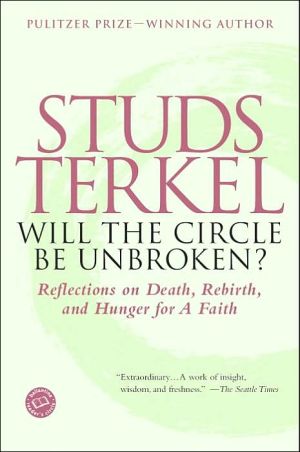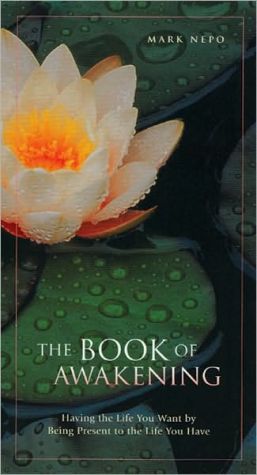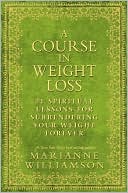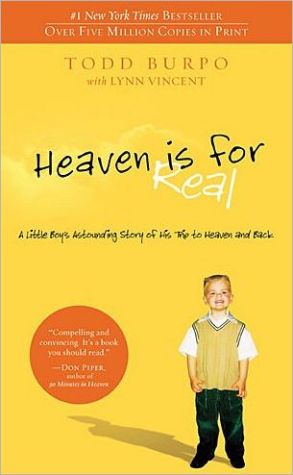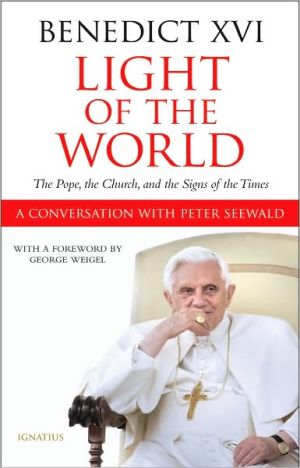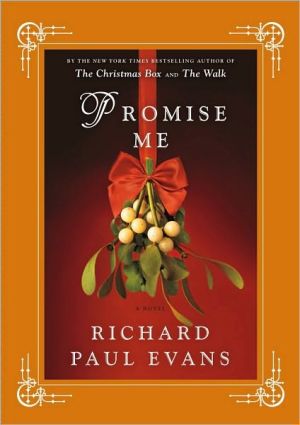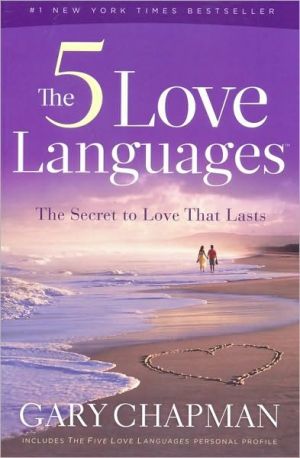Will the Circle Be Unbroken?: Reflections on Death, Rebirth, and Hunger for a Faith
“IT’S THE UNGUARDED VOICES HE PRESENTS THAT STAY WITH YOU. . . . Terkel’s interviews may not allay fears about death. But reading them certainly encourages life while we have it.”\ –The New York Times\ \ Whether it’s Working or The Great War, the legendary oral histories of Studs Terkel have offered indispensable insights into all areas of American life. Now, at eighty-eight, the Pulitzer Prize winner creates his most important work on a subject few can comfortably discuss: death.\ Here, in...
Search in google:
“IT’S THE UNGUARDED VOICES HE PRESENTS THAT STAY WITH YOU. . . . Terkel’s interviews may not allay fears about death. But reading them certainly encourages life while we have it.”–The New York TimesWhether it’s Working or The Great War, the legendary oral histories of Studs Terkel have offered indispensable insights into all areas of American life. Now, at eighty-eight, the Pulitzer Prize winner creates his most important work on a subject few can comfortably discuss: death.Here, in the voices of people both esteemed and unknown, are wise words, meaningful memories, and compassionate predictions about the experience of life’s end–and what may come after. A grad student explains how her two-year coma convinced her of the existence of reincarnation . . . A Hiroshima survivor reconciles her painful memories with the stoicism of her Japanese culture . . . Actress Uta Hagan expresses how her art is her religion and will be her legacy . . . Oscar-winning cinematographer Haskell Wexler relives his World War II ordeal, after a torpedo left him in a lifeboat among injured and dying comrades . . . An AIDS counselor reveals why healthy gay men may require the most crucial psychological help . . . and a retired firefighter admits he “never felt so alive” as when he was doing his dangerous job.From the sheer physical facts to the emotional realities to spiritual speculations, all aspects of death are openly expressed in this wonderful work, the stirring culmination of Studs Terkel’s brilliant career. Book Magazine Terkel has written about big issues before, but his latest oral history tackles the biggest: mortality. There are gut-wrenching dispatches from the front lines—from doctors, for example, who see strangers die every day—and heartrending accounts from those who've had to face their own mortality or that of loved ones, whether from the modern plagues of violence, cancer and AIDS or from just growing old. While some of these voices offer speculation (and quite a few good jokes) about what the afterlife might be like, there is wide agreement that what really matters is how we live our lives while we're here, and how we deal with the inevitability of our fate through personal beliefs. Some of Terkel's interlocutors might be described as extraordinary—people who, through luck, strength or some combination of the two, have beaten death. (There's even a typically wise and funny conversation with Dresden survivor Kurt Vonnegut.) But mostly, the book features ordinary people who nevertheless have extraordinary things to say on the meaning of life. This is a powerful, inspiring book. —Eric Wargo
Introduction\ I’VE COURTED DEATH ever since I was six. I was an asthmatic child. With each labored breath, each wheeze, came a toy whistle obbligato. At my bedside, my eldest brother, to comfort me, would whistle back “I’m Forever Blowing Bubbles,” in cadence with my breathing. It was funny, and pleasing, but not much help.\ That plus a couple of bouts with mastoiditis, head swathed in bandages, made my awakening the next morning a matter of touch and go. What troubled me was not that I wouldn’t make it, but that I would no longer enjoy the whimsical care of my father and two brothers. My mother was another matter; her hypertense attention more often than not added to my discomfort.\ Death itself was too abstract an idea for me then, though I had, in a cursory fashion, become acquainted with the fact of death. For a week or so, there had been a warning sign on the door of the adjacent house: SCARLET FEVER. CONTAGIOUS. It was taken down the day after the girl inside died. She was my contemporary. Still, near as she was, I felt somewhat detached, only vaguely saddened. My ailments, though serious, were not of epidemic proportions. Nor did the unfortunate girl have two brothers and a gentle father who brought forth phlegmy laughter.\ Of course, I had some difficulty, a fear really, of falling asleep. The idea of counting sheep might have worked had I been the child of a Basque shepard in Idaho. I really knew nothing about sheep, not that I had anything against them. I was living in Chicago, where a fair south wind blowing in from the stockyards wafted the aroma of slaughtered cattle toward our rooming house on Flournoy Street. No, there was really nothing soporific in counting cows.\ My brother, an assiduous newspaper bug, suggested counting celebrated names, names that made headlines. Charlie Chaplin. Caruso. The Bambino. Clara Bow, the “It” Girl. Peggy Hopkins Joyce. In an inspired moment, he dropped the names of the celebrated lovers Ruth Snyder and Judd Gray, who had just been executed for bopping her husband on the head with a heavy, leaden window sash. Nah. It did nothing for my sleeplessness.\ Astonishingly, it was my first awareness of baseball that turned the trick; at least, for a year or two. The Cleveland Indians had beaten the Brooklyn Dodgers in the World Series of 1920. Each night, the names of these new celebrities rolled from my tongue as I signed off. Stanley Coveleski, the Indians’ pitcher, who had won three games. Stan-ley Cov-el-es-ki. Six salubrious syllables. The peerless Tris Speaker, who covered center field like a comfortable quilt. (A sports writer’s apt phrase, my brother informed me.) Bill Wambsganns, the second baseman, who pulled off the unassisted triple play. Wambsganns. The name’s slow pronunciation had the pleasant, slumberous effect of a Dutch hot chocolate. Some thirty years later, when a television program with which I was involved, Studs Place, went off the air, I received a scrawled, handwritten letter from Cleveland. I remember a passage: “I am sorry. I enjoyed your program because it gave me a feeling of heimweh, an old Dutch word for homesickness. I was once a baseball player. They called me Wamby.” It was signed Bill Wambsganns. I replied, though I neglected to tell him how he had helped me through my insomnia.\ After a few years, when I had recovered from my childhood ailments, the effects of this nocturnal ritual wore off. Once again, I was in the thrall of sleeplessness. Now, a touch of fear that I might indeed die in my sleep distinctly possessed me. It brought forth a habit that still obsesses me. Whenever I’m about to doze off, I deliberately unclasp my hands and remove them from my breast. Every night. Even now.\ Was it that photograph I saw on the front page of the morning Hearst newspaper seventy-eight years ago? The late Pope Benedict XV lay in state. On the catafalque, the pontiff’s hands were clasped across his breast. It was the first image I remember of a dead person in a casket. From time to time, my young Catholic friends suggested a prayer. “If I should die before I wake…” No soap. I didn’t want any Lord my soul to take because I obstinately insisted on waking up the next morning.\ Fortunately, at the age of thirteen, I had a young English teacher in my freshman class at McKinley High School. With his scraggly mustache and tubercular mien, he bore a remarkable resemblance to Robert Louis Stevenson. He had assigned us Coleridge’s “The Rime of the Ancient Mariner.” And–bingo!–there was a five-line stanza that did the trick.\ Oh sleep, thou art a gentle thing Beloved from pole to pole!\ To Mary Queen, the praise be given,\ She sent the gentle sleep from Heaven,\ That slid into my soul.\ For years, I mumbled those lines before sacking out. And it worked–after a fashion. (Ironically, my young Catholic friends had scored a point. They knew who Mary Queen was; I didn’t.)\ Now, at eighty-eight, after a quintuple bypass among other medical adventures, those words have lost their charm. Too many of my old friends, contemporaries, have died. Fortunately, I’ve discovered a new way of popping off to sleep. I count down the names of those departed buddies. Unfortunately, the list has grown exponentially during these last few years. Amend that: every month, every week, I spot more familiar names in the obituary columns.\ Mordant though it may sound, it’s not an unpleasant way of sacking out. I recall funny stories, jokes, and even imagined amours, especially after a few drinks, say, at Riccardo’s, a favorite watering hole in Chicago, but now transmogrified into an “in” place for Generation X. I have a good number of young friends, who are delightful company, generous-hearted, witty, and all that. Yet, there is that slight ache–heimweh, as Bill Wambsganns put it.\ My fellow octogenarian Charlie Andrews explains: “Have you heard the one about the old sport who married a much younger woman? It worked for a couple of years. One day, a mutual friend encounters him. The old boy informs him that they’ve split up. ‘She didn’t know the songs.’” My young friends do my heart good every time I see them, but they don’t know the songs.\ Naturally, when I pick up a newspaper these days, the first place I turn to isn’t sports, or arts, or the business of business, or the op-eds. I immediately turn to the obituaries. The old doggerel with which many mature readers may be acquainted has replaced Coleridge as my mantra.\ I wake up each morning and gather my wits,\ I pick up the paper and read the obits.\ If my name is not in it, I know I’m not dead,\ So I eat a good breakfast and go back to bed.\ *\ • *\ This is the one book I never thought I’d write. It was too big for me; too abstract. It was more in the domain of the metaphysician or the minister. Yet the idea was put forth some thirty years ago.\ Was it 1970? ’71? Gore Vidal, at the Ambassador East Hotel bar in Chicago, suggested death as the subject for a book. I stared into my drink. No bells rang. My works had been concerned with life and its uncertainties rather than death and its indubitable certainty.\ In all my books, my informants–mostly the uncelebrated, heroes of the “ordinary”–had recounted, in their own words, the lives they had lived, the epochs they had survived. How did it feel to be a certain person in a certain circumstance at a certain time in our country’s twentieth century? During the Great American Depression, what was it like to be that twelve-year-old boy seeing his father trudge home at eleven in the morning with his toolchest over his shoulder only to become an idler for the next ten years? During World War II, what was it like to be a mama’s boy sitting tight in that landing craft crossing the English Channel, heading for Normandy? What was daily worklife like for the schoolteacher, the waitress, the spotwelder or the storekeeper? What did the blacks in our society really think of whites or the other way around? How did the elders feel as they grew even more so in a society where their power ebbed as their span increased?\ These were challenges I could handle, for better or worse–something I could put my hands on. In recalling actual experiences, my colleagues, the true authors of these works, found their own eloquence and poetry. Words from the seemingly inarticulate flowed like wine. At times they were as astonished as I was.\ Consider the young mother in the public project. It was an integrated complex of the poor. I can’t recall whether she was white or black. The conversation took place in the sixties. The tape recorder had not yet become the household tool it is today. Her three little kids were hopping around, demanding to hear Mama’s voice on tape. I played it back. As she caught her words, she gasped. Hand touching mouth, she murmured: “I never knew I felt that way…” Bingo! A score for me as well as for her. An experience recounted, a revelation to oneself.\ But what about the one experience none of us has had, yet all of us will have: death? Now in my late eighties, Gore Vidal’s challenge of some thirty years ago had come back to haunt me. What is there to remember of a time and place at which none of us has yet arrived? Boy–what a challenge! I no longer stared at my drink. I downed the martini and the bells began to ring.\ In what follows, you may be astonished as I was, while scrounging around, to discover that we reflect on death like crazy much of our lives. The storytellers here, once started on the subject, can’t stop. They want to talk about it; whether it be grief or guilt or a fusing of both on the part of the survivors; or thoughts about the hereafter–is it is or is it ain’t? You’ll hear voices offering all sorts of opinions: some are believers, others put forth the challenge, “show me.”\ For so many there’s a recurring refrain, “I’m not religious, I’m spiritual,” as though they sought separation from the institution, yet, as individuals, truly believed.\ Invariably, those who have a faith, whether it is called religious or spiritual, have an easier time with loss. They find solace in believing there is a something after–that they will in some way, in some form, again meet or even merge with the departed one. Nonbelievers have no such comfort. They go with Gertrude Stein’s observation in another context: “There is no there there.” Nada.\ All of the doctors I have come to know and respect, including my cardiologist, my surgeon, and my internist, Quentin Young has been our family doctor for the last forty years. I’m certain that his ebullience, his spirit of bonhomie, and his skills have been key factors in my living beyond my traditionally allotted span. have urged me to undertake this project. We, as a matter of course, reflect on death, voice hope and fear, only when a dear one is near death, or out of it. Why not speak of it while we’re in the flower of good health? How can we envision our life, the one we now experience, unless we recognize that it is finite?\ It is sweet a irony that my first book of the twenty-first century (possibly my last) is about death. Yet these testimonies are also about life and its pricelessness, offering visions, inchoate though they be, of a better one down here–and, possibly, up there.
AcknowledgmentsxiiiIntroductionxvPrologue: BrothersTom Gates, a retired fireman3Bob Gates, a retired police officer11Part IDoctorsDr. Joseph Messer17Dr. Sharon Sandell24ERDr. John Barrett29Marc and Noreen Levison, a paramedic and a nurse39Lloyd (Pete) Haywood, a former gangbanger45Claire Hellstern, a nurse53Ed Reardon, a paramedic58Law and OrderRobert Soreghan, a homicide detective64Delbert Lee Tibbs, a former death-row inmate67WarDr. Frank Raila80Haskell Wexler, a cinematographer89Tammy Snider, a Hiroshima survivor (hibakusha)96Mothers and SonsV.I.M. (Victor Israel Marquez), a Vietnam vet105Angelina Rossi, his mother115Guadalupe Reyes, a mother119God's ShepherdsRev. Willie T. Barrow124Father Leonard Dubi129Rabbi Robert Marx134Pastor Tom Kok140Rev. Ed Townley149The StrangerRick Rundle, a city sanitation worker155Part IISeeing ThingsRandy Buescher, an associate architect163Chaz Ebert, a lawyer174Antoinette Korotko-Hatch, a church worker179Karen Thompson, a student187Dimitri Mihalas, an astronomer and physicist194A View from the BridgeHank Oettinger, a retired printer202Ira Glass, a radio journalist207Kid Pharaoh, a retired "collector"210Quinn Brisben, a retired teacher216Kurt Vonnegut, a writer221The BoomerBruce Bendinger, an advertising executive and writer228Part IIIFathers and SonsDoc Watson, a folksinger235Vernon Jarrett, a journalist242Country WomenPeggy Terry, a retired mountain woman252Bessie Jones, a Georgia Sea Island Singer (1972)260Rosalie Sorrels, a traveling folksinger266The Plague ITico Valle, a young man274Lori Cannon, "curator" of the Open HandSociety279Brian Matthews, an ex-bartender, writer for a gayweekly287Jewell Jenkins, a hospital aide291Justin Hayford, a journalist, musician295Matta Kelly, a case manager305The Old GuyJim Hapgood314The Plague IINancy Lanoue317Out ThereDr. Gary Slutkin324Part IVVissi d'ArteWilliam Warfield, a singer and teacher333Uta Hagen, an actress339The ComedianMick Betancourt345Day of the DeadCarlos Cortez, a painter and poet352Vine Deloria, a writer and teacher356Helen Sclair, a cemetery familiar363The Other SonSteve Young, a father366Maurine Young, a mother372The JobWilliam Herdegen, an undertaker379Rory Moina, a hospice nurse385The End and the BeginningMamie Mobley, a mother393Dr. Marvin Jackson, a son397EpilogueKathy Fagan and Linda Gagnon, mothers401
\ From The CriticsTerkel has written about big issues before, but his latest oral history tackles the biggest: mortality. There are gut-wrenching dispatches from the front lines—from doctors, for example, who see strangers die every day—and heartrending accounts from those who've had to face their own mortality or that of loved ones, whether from the modern plagues of violence, cancer and AIDS or from just growing old. While some of these voices offer speculation (and quite a few good jokes) about what the afterlife might be like, there is wide agreement that what really matters is how we live our lives while we're here, and how we deal with the inevitability of our fate through personal beliefs. Some of Terkel's interlocutors might be described as extraordinary—people who, through luck, strength or some combination of the two, have beaten death. (There's even a typically wise and funny conversation with Dresden survivor Kurt Vonnegut.) But mostly, the book features ordinary people who nevertheless have extraordinary things to say on the meaning of life. This is a powerful, inspiring book.\ —Eric Wargo \ \ \ \ \ \ \ Publishers WeeklyIn the past, Terkel (The Good War) has gotten people to talk about their concrete experiences, like family, war and the Depression, rather than an event that no one can talk about after having experienced it. Now Terkel, a gifted interviewer, encourages the subjects of this book to talk openly about their feelings regarding life's final frontier. The raconteurs who share their moving stories in this collection range from emergency room doctors and paramedics to public figures such as Kurt Vonnegut, NPR commentator Ira Glass and country music guitarist Doc Watson. Each of Terkel's subjects brings his or her unique insights to the mystery of death. For example, emergency room doctor Ed Reardon says we fear death because we don't understand it, and that it's hope that keeps us going while we're alive. Country woman Peggy Terry observes that death would not be so frightening if "we've fulfilled ourselves as human beings, not as collectors of stuff, money, and bank accounts." Tico Valle, a young Latino gay male, reflects on the death of his partner and the significance of reincarnation for understanding the meaning of life. Finally, Emmett Till's mother, Mamie Mobley, poignantly recalls her son's sacrifice: "Emmett had died that men might have freedom here on Earth. That we might have a right to life.... If Jesus Christ died for our sins, Emmett Till bore our prejudices." Terkel's refusal to overwhelm readers with his own philosophical reflections and his willingness to allow ordinary men and women to speak for themselves make this a stirring and enlightening collection that will lead readers to think more deeply about their own hopes and fears. (Oct.) Forecast: This is bound to be anotherbestseller for Terkel, who will tour five cities to promote it. First serial was sold to the Atlantic Monthly. Copyright 2001 Cahners Business Information.\ \ \ KLIATTAt the age of 89, professional interviewer Terkel set about to learn what people think about death. What, he wanted to know, were their experiences of it? How did they view their own inevitable deaths? He ranges very widely, beginning with interviews of firemen and other emergency workers whose jobs make it necessary to do all in their power to save lives, but who also often see death happen. Readers view death through the eyes of medical personnel, funeral home workers, law enforcement officers, a street criminal, a death row inmate, a woman who had emerged from a long coma, some who have had near-death experiences, minority persons whose experience of early death was greater than most, sufferers from fatal diseases such as cancer and AIDS, clergy, and military personnel. There is a powerful account of megadeath—one woman's experience when the atomic bomb was dropped on her home city of Hiroshima. Some well-known persons speak out, but most of the interviewees are ordinary persons dealing as best they can with the only universal experience other than birth, The interviews, as is true in Terkel's other books, often seem to start somewhere in the middle of the interview and end abruptly. A sense of loss pervades, as one might expect, and there is a palpable wrestling with religious belief. He does not neglect the mechanics of dealing with death. One feels the persons interviewed have been starkly honest. Terkel's wife died not long after he began work on this book, and the raw emotions expressed by the persons interviewed surely reflect some of his own feelings. Every library will have requests for this, and librarians will want to recommend it for use by discussion groups. This is StudsTerkel at the top of his form. KLIATT Codes: SA—Recommended for senior high school students, advanced students, and adults. 2001, Ballantine, 407p., Boardman\ \ \ \ \ Library JournalTerkel, the Pulitzer Prize-winning author of a dozen books on American life (most recently The Spectator), writes in the introduction about his own encounters with death narrowly avoided first as an asthmatic child seeking help in falling asleep and then as an adult undergoing quintuple bypass surgery. He also describes the deaths of his father and, more recently, his 87-year-old wife. Like his previous books, this current volume collects interviews with a variety of people on a particular theme. Here he speaks with "sixty heroes . . . offering me their bone-deep, honest testimonies [which] have been a palliative beyond prescription." Terkel rightly claims that the book deals with "death, of course, but understood only by living to the full its long prelude, life." His heroes include medical personnel, strangers, parents, clergy, journalists, performers, and others, some well known, such as NPR's Ira Glass, author Kurt Vonnegut, and country singer Doc Watson, and some less familiar. Together they offer a wide spectrum of reflections on death and life. Highly recommended for public and seminary libraries. [See p. 210 for an interview with Terkel. Ed.] Carolyn M. Craft, Longwood Coll., Farmville, VA Copyright 2001 Cahners Business Information.\ \ \ \ \ Kirkus ReviewsBroadcaster/writer Terkel (The Spectator, 1999, etc.) explores death and its impact on our sense of ourselves and on the meaning in our lives, in the latest in his pioneering series of oral histories. The 60 interview subjects include professionals concerned with death and dying (doctors, social workers, clergy, police officers, firefighters), survivors of comas or near-death experiences, veterans of wars from WWII to Vietnam, singers and actors, civil-rights-movement veterans and AIDS activists. Many, like the astonishing Kid Pharaoh, will be familiar to readers of other Terkel volumes. Here, they share their reflections on the deaths of friends and loved ones, on the prospect of their own demise, and on their faith or lack if it-in the hereafter, in God, in human love, in the goodness of life, in the heartbreaking beauty of finitude. It's remarkable how many of them have experienced some kind of communion with their beloved dead. There is food for reflection here for anyone both fascinated and frightened (and who isn't?) by the thought of death. Readers will long remember Lloyd "Pete" Haywood, shot by a gangbanger and left for dead in the elevator of a housing project, whose faith allows him to refuse revenge; Dimitri Mihalis, a physicist who, having passed through depression, traumatic brain injury, and lithium psychosis, can still say, "My life has been touched by grace"; Maureen Young, the mother of a teenager killed, seemingly at random, by a teenaged gang member, who finds herself reaching out to her son's killer; William Herdegen, a remarkably compassionate undertaker unafraid of the bodies of the victims of AIDS. Unfortunately, others interviewed blend together; for all theirvariety of race, profession, belief (or lack of it), and sexual orientation, perhaps too many of his subjects are in Terkel's own progressive, activist mold. Like many medicines, probably best taken in small doses.\ \
